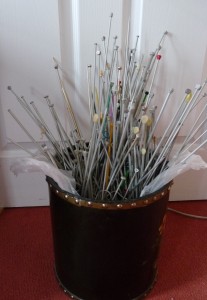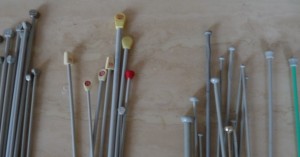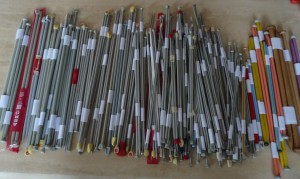How to buy and sort second hand knitting needles
On my stall I sell used knitting needles at 50p a pair. For this my customers can expect the needles to be paired, clean and not bent.
I buy job lots of knitting needles at car boot sales. But not every job lot that I see. Some job lots are a mass of dirty, bent metal with not a matching pair to be seen. Some house clearance guys (and they are usually guys) ask far too much for them – this weekend I was quoted seven quid for a box containing not more than a dozen pairs! I’m happy at three or four quid at the most for a good load. Remember, I will need to spend time sorting them into pairs and that about half will have to be disposed of (or used in the garden as plant supports) because they don’t have a mate, they are past cleaning or they are not straight.
Today I have decided to sort through three job lots that I have accumulated. First I remove the needles which have already been paired and the obvious pairs (say the only pair of large wooden needles) and also things like circular knitting needles, row counters and so on. Then I sort the rest into various piles eg triangular topped, round topped, coloured plastic.
I grab hold of a pile, hold it like a bunch of flowers and allow the tips to drop onto my knee. The needles then drop into different lengths. This makes it relatively easy to sort into pairs and discard the singletons.
Once paired, I check for straightness. The obviously bent are immediately discarded. I check the rest by holding the two needles together top-to-tail and checking if there is an ellipse between them.
Not straight enough!
If straight, I check for cleanliness. If needles had previously been held together by an elastic band which has since perished there is often a sticky mark but this can usually be washed off with washing up liquid and water.
The pairs obviously need to be held together. As above, elastic bands may perish, and sticky tape used straight on the needles is a no-no. Some people use oddments of wool or ribbon. My preferred method is to keep the needles top-to-toe, roll paper around at each end, securing the paper (but without touching the needle) with sticky tape. The needles are then easily removed without having to cut yarn or undo a bow and the paper pair-holder can be re-used. As they are secured top and bottom, they are less likely to escape, get bent or to do the splits!


Paired,clean and straight Modern art (aka discarded needles)
The paired needles have to be sorted into sizes. Easier said than done when job lots in the UK will most likely contain both metric sizes and the pre-metric sizes from 14 – 000 (the higher the number, the smaller the needle). For this you need a metric conversion chart and/or a needle gauge. I put them in rough size order first.
The larger size needles are more in demand but as you can see from the picture there are much fewer of them!





Gillian foster April 21, 2018 at 7:40 pm
Have you got 2.5mm double pointed needles i could buy ?
Christine Markey April 27, 2018 at 11:22 am
Hi – many thanks for your enquiry. The closest I have at present is 2.75mm. I’ll get in touch via your personal email if I do come across any in the near future. The cost would be 50p plus postage or you would be able to collect them if you live near me or if we both attend the same car boot sale.
Actually DPNS are a good point (pun intended!) When sorting second hand knitting needles, DPNS offer an additional challenge in that they are not marked and so if they are not already sorted into their sets of 4, then a size gauge will be needed. As this is time consuming and there is not a great call for DPNS, I tend to put them on as a job lot on eBay.
Best Wishes
Christine